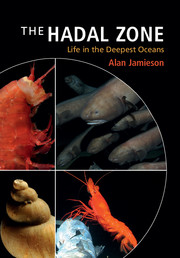Book contents
- Frontmatter
- Dedication
- Contents
- Preface
- Acknowledgements
- Part I History, geology and technology
- 1 The history of hadal science and exploration
- 2 Geography and geology
- 3 Full ocean depth technology
- Part II Environmental conditions and physiological adaptations
- Part III The hadal community
- Part IV Patterns and current perspectives
- Appendix
- References
- Index
- Plate section
3 - Full ocean depth technology
from Part I - History, geology and technology
Published online by Cambridge University Press: 05 February 2015
- Frontmatter
- Dedication
- Contents
- Preface
- Acknowledgements
- Part I History, geology and technology
- 1 The history of hadal science and exploration
- 2 Geography and geology
- 3 Full ocean depth technology
- Part II Environmental conditions and physiological adaptations
- Part III The hadal community
- Part IV Patterns and current perspectives
- Appendix
- References
- Index
- Plate section
Summary
Scientific endeavour into the world’s ecosystems, whether on land or in the sea, tends to occur in three stages: exploration, observation and experimentation (Tyler, 2003). The discovery and subsequent exploration of marine ecosystems, whether serendipitously or otherwise has been ongoing since the birth of marine science and provides the rudimentary groundwork for all future research. As detailed in Chapter 1, this discovery and exploration has culminated in the mapping of the world’s oceans in their entirety. In shallow and coastal seas, the observational and experimental stages of research have been ongoing for more than a century and are a well-established practice due to the relative ease of access compared to deep environments. In shallow-water ecosystems, the fauna and environmental correlates are readily accessible for study, both in situ and in the laboratory, a luxury rarely obtainable in deep-sea research. The inherent nature of the deep sea does not lend itself readily to examination using the experimental tools and procedures of typical laboratory settings and research is often further hampered by the great distances from shore and depths from the surface. As a result, deep-sea sampling has lagged behind that of coastal and inshore research. The understanding of the deep-sea environment has greatly increased in the last century, particularly in the last 50 years, due to the ever-increasing sampling effort driven by the ever more apparent importance of the oceans on our planet.
It has recently been said that ‘if there are “ages” in science, the deep-sea biological community is in the later stages of the age of observation’ (Tyler, 2003). While this is certainly true for the general deep-sea environment, hadal research is more likely placed in the early stages of observation. The technical challenges of exploration, observation and experimentation that have hindered research at bathyal and abyssal depths are exacerbated at hadal depths. It is the technological capabilities that underpin progress in understanding these deep environments, as even the most basic scientific question is unlikely to be answered without a heavy reliance on technology.
- Type
- Chapter
- Information
- The Hadal ZoneLife in the Deepest Oceans, pp. 45 - 72Publisher: Cambridge University PressPrint publication year: 2015



